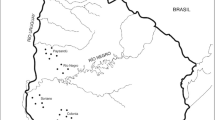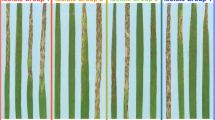Abstract
Powdery mildew populations were analysed to determine the effects of a resistance elicitor and cultivar mixtures on genetic complexity and diversity. Isolations were made from a range of spring barley monocultures and mixtures in a field trial, and characterised for virulence and RAPD profile. In a second trial, isolates were taken from a single mixture from untreated and resistance elicitor-treated areas and from the components of the mixture in monoculture. The mildew population was not only highly heterogeneous for virulence characteristics, but also proved heterogeneous within pathotypes for molecular markers, indicating the major impact of sexual recombination on population structure and the lack of clonal dominance. Various diversity measurements were compared and the value of dissimilarity measurement for revealing genetic distance within a population was highlighted. There was a trend towards increasing complexity as the season progressed, but there was no consistent relationship between cultivar or mixture, disease control treatment, fertiliser treatment, replicate or position in trial, and pathogen genotype. Whilst the resistance elicitor did reduce mildew by 78% in the first trial, and there was no interaction with fertiliser level in its expression, control was substantially less in the second trial. There were no differences between mildew isolates from elicitor and control treatments. It was felt that more effective and consistent resistance elicitors need to be developed before it can be stated that they are unlikely to be eroded by selecting resistant or adapted mildew genotypes.
Similar content being viewed by others
References
Andrivon D and de Vallavieille-Pope C (1995) Race diversity and complexity in selected populations of fungal biotrophic pathogens of cereals. Phytopathology 85: 897-905
Brown JKM and Jørgensen JH (1991) A catalogue of mildew resistance genes in European barley varieties. In: JH Jørgensen. Integrated control of cereal mildews: virulence patterns and their change. pp. 263-286. Risø National Laboratory, Roskilde, Denmark
Chen XM, Line RL and Leung H (1993) Relationship between virulence variation and DNA polymorphism in Puccinia striiformis. Phytopathology 83: 1489-1497
Chen XM, Line RL and Leung H (1995) Virulence and polymorphic DNA relationships of Puccinia striiformisf. sp. hordeito other rusts. Phytopathology 85: 1335-1342
Chin KM and Wolfe MS (1984) Selection on Erysiphe graminisin pure and mixed stands of barley. Plant Pathology 33: 535-546
Dileone JA and Mundt CC (1994) Effect of wheat cultivar mixtures on populations of Puccinia striiformisraces. Plant Pathology 43: 917-930
Groth JV and Roelfs AP (1987) The concept and measurement of phenotypic diversity in Puccinia graminison wheat. Phytopathology 77: 1395-1399
Huang R, Kranz J and Welz HG (1994) Selection of pathotypes of Erysiphe graminisf. sp. hordeiin pure and mixed stands of spring barley. Plant Pathology 43: 458-470
Huang R, Kranz J and Welz HG (1995) Increase of complex pathotypes of Erysiphe graminisf. sp. hordeiin two-component mixtures of spring barley cultivars. Journal of Phytopathology 143: 281-286
Jennings JM, Newton AC and Buck KW (1997) Detection of polymorphism in Puccinia hordeiusing RFLP, RAPD and differential cultivars and analysis of the intergenic spacer region of rDNA. Journal of Phytopathology 145: 511-519
Jones IT and Davies JER (1985) Partial resistance to Erysiphegraminis hordeiin old European barley varieties. Euphytica 34: 499-507
Kolar M, Punt PJ, van den Hondel CAMJJ and Schwab H (1988) Transformation of Penicillium chrysogenumusing dominant selection markers and expression of an Escherichia coli locZfusion gene. Gene 62: 127-134
Kølster P, Munk L, Stølen O and Løhde J (1986) Near isogenic barley lines with genes for resistance to powdery mildew. Crop Science 26: 903-907
Lyon GD, Reglinski T and Newton AC (1995) Novel disease control chemicals: The potential to ‘immunize’ plants against infection. Plant Pathology 44: 407-427
Lyon GD and Newton AC (1997) Do resistance elicitors offer newopportunities in integrated disease control strategies? Plant Pathology 46: 636-641
Maniatis T, Fritsch EF and Sambrook J (1982) Molecular Cloning. A Laboratory Manual. Cold Spring Harbor Laboratory, Cold Spring Harbor, New York
Mundt CC (1994) Techniques for managing pathogen co-evolution with host plants to prolong resistance. pp. 193-205. In: Proceedings of the International Rice Research Conference, April 1992. P. S. Teng, K. L. Heong, and K. Mooody, eds. P. O. Box 933, 1099 Manila, Philippines. International Rice Research Institute
Müller K, McDermott JM, Wolfe MS and Limpert E (1996) Analysis of diversity in populations of plant pathogens: the powdery mildew pathogen across Europe. European Journal of Plant Pathology 102: 385-395
Newton AC and Hackett CA (1994) Subjective components of mildew assessment on spring barley. European Journal of Plant Pathology 100: 395-412
Newton AC, Thomas WTB and Goleniewski G (1996) Effects of nitrogen on mildew levels and yield in major gene and partial resistance spring barley cultivar mixtures. pp. 165-172. In: Integrated control of cereal mildews and rusts: towards coordination of research across Europe. Proc. Workshop COST 817, Zürich 5-10 Nov 1994, E. Limpert, M. R. Finckh and M. S. Wolfe, eds. European Commission, Luxembourg, 276 p
Newton AC (1997) Cultivar mixtures in intensive agriculture. In: Gene-for-gene relationship in plant parasite interactions. Eds: IR Crute, J Burdon and E Holub, pp. 65-80. CAB International, Wallingford, Oxford
Pinon J and Frey P (1997) Structure of Melampsora laricipopulinapopulations on wild and cultivated poplar. European Journal of Plant Pathology 103: 159-173
Reglinski T, Newton AC and Lyon GD (1994) Assessment of the ability of yeast-derived resistance elicitors to control barley powdery mildew in the field. Journal of Plant Disease and Protection 101: 1-10
Sanders HL (1968) Marine benthic diversity: A comparative study. American Naturalist 102: 243-282
Simpson EH (1949) Measurement of diversity. Nature 163: 688
Slater SE and Clarkson JDS (1998) Mildew of barley. pp. 31-39. In: United Kingdom Cereal Pathogen Survey Annual Report for 1996. National Institute of Agricultural Botany, Cambridge, UK
Wolfe MS (1984) Trying to understand and control powdery mildew. Plant Pathology 33: 451-466
Wolfe MS, Braendle UE, Koller B, Limpert E, McDermott JM, Müller K and Schaffner D (1992) Barley mildew in Europe: population biology and host resistance. Euphytica 63: 125-139
Wolfe MS and Finckh MR (1996) Diversity of host resistance within the crop: effects on host, pathogen and disease. In: Resistanceof crop plants. Eds: H Hartleb, R Heitefuss and HH Hope, Gustav Fischer Verlag
Author information
Authors and Affiliations
Rights and permissions
About this article
Cite this article
Newton, A.C., Hackett, C.A. & Guy, D.C. Diversity and Complexity of Erysiphe graminis f.sp. hordei Collected from Barley Cultivar Mixtures or Barley Plots Treated with a Resistance Elicitor. European Journal of Plant Pathology 104, 925–931 (1998). https://doi.org/10.1023/A:1008646300300
Issue Date:
DOI: https://doi.org/10.1023/A:1008646300300




